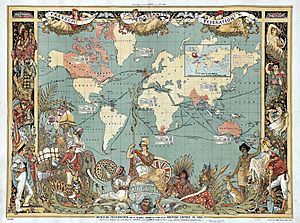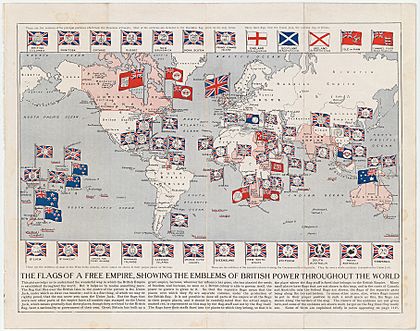Pax Britannica facts for kids

Pax Britannica means "British Peace" in Latin. It was a time when the British Empire was the most powerful nation in the world. Britain acted like a "global policeman" during this period. This meant it often helped keep peace and order around the world.
This peaceful time lasted from 1815 to 1914. During these years, the British Empire grew a lot. About 10,000,000 square miles (26,000,000 km2) of land were added. Also, around 400 million people became part of the Empire. After beating Napoleonic France, Britain had no major rivals. Only Russia in Central Asia came close. When Russia tried to expand into the Balkans, Britain and France stopped them. They fought in the Crimean War (1853–1856). This war helped protect the Ottoman Empire.
Britain's Royal Navy was incredibly strong. It controlled most important sea trade routes. No other navy could challenge its power. Britain also had a huge influence on world trade. This meant it controlled access to many regions. These included Asia, North America, Oceania, and Africa. Britain even helped the United States with the Monroe Doctrine. This helped the U.S. keep its economic power in the Americas. British businesses were so strong that they had an "informal empire". This meant they had a lot of control even outside their official colonies.
Contents
How the British Peace Began
After losing the Thirteen Colonies in the American Revolution, Britain looked elsewhere. It focused on Asia, the Pacific, and later Africa. This led to the growth of the Second British Empire. The Industrial Revolution started in Britain in the late 1700s. New ideas about free trade also emerged. One important idea came from Adam Smith's book, The Wealth of Nations (1776). By the 1840s, free trade became a key British policy. This helped Britain's economy grow and made it a financial leader.
From 1815, after the Napoleonic Wars, until World War I in 1914, Britain was the world's most powerful country. The "British Peace" on sea trade routes began in 1815. This was when Britain took over British Ceylon (now Sri Lanka). In the British Residency of the Persian Gulf, local Arab rulers signed treaties. These treaties gave Britain protection over the region. Britain also made an anti-piracy treaty in 1820. It was called the General Maritime Treaty of 1820. All Arab rulers in the area had to sign it. In 1853, Arab rulers signed the Perpetual Maritime Truce. They agreed not to fight at sea. In return, Britain protected them from outside attacks.
The British Armed Forces were very strong. Europe was divided and somewhat weak. This helped Britain's military and trade grow. The Royal Navy was present on all oceans. Even outside its official empire, Britain controlled trade. This included trade with countries like China, Siam, and Argentina. After the Congress of Vienna, Britain's economy kept growing. This was thanks to its strong navy and efforts to keep a balance of power in Europe.
Britain's Role as Global Policeman
During this time, the Royal Navy helped other nations. For example, it helped stop piracy. It also worked to block the slave trade. The Slave Trade Act 1807 had banned slave trading in the British Empire. After this, the Royal Navy created the West Africa Squadron. The British government also made international treaties. These allowed them to enforce the ban on slave trade.
However, sea power did not always work on land. Major land wars happened between European powers. These included the Crimean War, the Franco-Austrian War, and the Franco-Prussian War. The Royal Navy fought in the First Opium War (1839–1842) and Second Opium War (1856–1860). These wars were against Imperial China. The Royal Navy was stronger than any other two navies combined. From 1815 until the late 1800s, only France was a possible naval threat.
A very important event was the Anglo-Egyptian War. This led to Britain occupying Egypt for 70 years. Even though the Ottoman Empire still officially owned Egypt, Britain was in charge. This event changed the balance of power in the world. It gave Britain a secure route to India. It also made Britain powerful in the Eastern Mediterranean and the Middle East.
Britain traded goods and money with countries worldwide. It adopted a free trade policy after 1840. New technologies also helped Britain's power grow. The steamship and the telegraph were invented in the late 1800s. These allowed Britain to control and defend its empire better. By 1902, telegraph cables connected the entire British Empire. This network was called the All Red Line.
The End of the British Peace
The Pax Britannica started to weaken. This happened as the peace in Europe, set up by the Congress of Vienna, broke down. Relations between the major European powers became tense. Issues like the decline of the Ottoman Empire caused problems. This led to the Crimean War. Later, new countries like Italy and Germany formed. This happened after the Franco-Prussian War. Both of these wars involved Europe's biggest states and armies.
The growth of industries in Germany, the Empire of Japan, and the United States also played a role. This meant Britain's industrial lead slowly decreased in the late 1800s. The start of World War I in 1914 marked the end of the Pax Britannica. However, the British Empire remained the largest colonial empire. It stayed that way until countries started gaining independence after World War II ended in 1945. Britain remained a leading power until the Suez Crisis in 1956. During this crisis, British and French troops had to leave Egypt. They were pressured by the United States and the Soviet Union.
See also
- Historiography of the British Empire
- Imperial Federation
- List of wars involving the United Kingdom
- Pax Americana
- Pax Sovietica
- Pax Sinica
- Pax Romana
- Pax Hispanica
- Political history of the world


